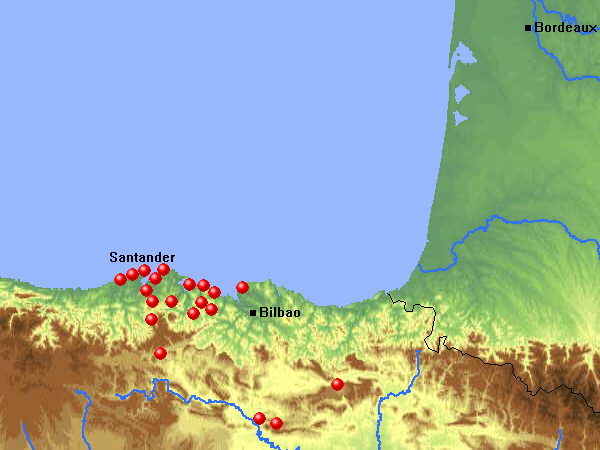The main objective is to help reconstruct the patterns of geographic mobility and resource procurement zones of Late Pleistocene, especially Magdalenian, hunter-gatherer cultures in northern Spain and throughout greater southwestern Europe. The research is based on the identification, characterization and comparison of chert materials from natural outcrops with chert artifacts from Late Pleistocene archaeological contexts through macroscopic, petrographic, and trace-element analysis.
Geographically, these regions of northern Spain are characterized as a narrow, costal strip of land, approximately 40-60 km wide, situated between the Cantabrian Sea to the north and the Cantabrian Cordillera to the south.
Topographically, they are defined by numerous, narrow, high relief karstic river valleys that drain from south to north.

Overview of major sampling points in Northern Spain from the collection of John Rissetto.
The area south of the cordillera consists mainly of Upper Cretaceous formations, some of which contain chert outcrops. In the Basque region, the prominent chert-bearing strata are located in the Upper Cretaceous formations along the coast and the Tertiary formations situated in the montane interior.
The size, shape, and cortical texture of the chert nodules from both the Lower and Upper Cretaceous outcrops are considered generally similar. However, the overall size of the Upper Cretaceous and Tertiary nodules from the Basque outcrops are, on average, larger than those of the Cretaceous nodules from Cantabrian outcrops.
The prominent difference between the materials from the Cretaceous and Tertiary period outcrops are the overall quality of the chert itself. The Lower Cretaceous chert materials are considered, on average, of low to medium overall knapping quality. This is caused mainly by the consistently low ratio of micro- or cryptocrystalline silica to unsilicified carbonate within the rock matrix and their frequent irregular fracture pattern. The irregular fracture pattern is possibly caused by the increased presence of internal flaws.
The Upper Cretaceous and Tertiary chert materials are considered, on average, of medium to high overall knapping quality. This is based in part on the consistently high ratio of micro- or cryptocrystalline silica to unsilicified carbonate in the rock matrix, which creates a more reliable, isotropic structure with accordingly conchoidal fracture pattern.
Very little, if any, evidence was found for the natural secondary transport of chert materials beyond a 0.5 km perimeter around the primary outcrop. This is supported by the author's survey work around primary outcrops. It is likely that natural transport of chert materials did occur, but has either not been identified or is quickly buried or obscured due to natural processes.
At secondary chert source areas, which were identified predominantly along the coast, it is assumed that groups of hunter-gatherers would have easily collected loose chert nodules intermixed along the rocky beaches.
Chert materials represent >85 to 90% of the Late Pleistocene hunter-gatherer lithic assemblage in northern Spain. These materials were used to produce a lithic tool kit that consisted primarily of prepared blade and bladelet core technology. These debris types, along with plain flakes, were the principal ground form on which all major utilitarian and specialized tools were made. The tools, mainly backed bladelets, endscrapers, burins, notches, denticulates, and scrapers, were inset into handles made of perishable organic materials.